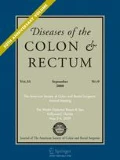Abstract
Pilonidal disease is treated by follicle removal and lateral drainage. The method is suited to outpatient management and gives minimal disability and good long-term control. Other treatment methods for management of the unhealed midline pilonidal incision are discussed. Results are satisfactory to as long as nine years on follow-up. Microphotographs demonstrate that pilonidal disease arises from hair follicles in the skin.
Similar content being viewed by others
References
Bascom JU. Pilonidal disease: origin from follicles of hairs and results of follicle removal as treatment. Surgery 1980;87:567–72.
Bascom JU. Pilonidal disease: correcting overtreatment and undertreatment. Contemporary Surgery 1981;18:13–8.
Buie LA, Curtiss RK. Pilonidal disease. Surg Clin North Am 1952;32:1247–59.
Kooistra MP. Pilonidal sinuses: review of the literature and report of 350 cases. Am J Surg 1942;4:3–17.
Notaras MJ. A review of three popular methods of treatment of postanal (pilonidal) sinus disease. Br J Surg 1970;57:886–90.
Weale FE. A comparison of barber's and postanal pilonidal sinuses. Br J Surg 1964;51:513–6.
Golz A, Argov S, Barzilai A. Pilonidal sinus disease: comparison amount various methods of treatment and a survey of 160 patients. Curr Surg 1980;37:77–85.
Lord PH, Millar DM. Pilonidal sinus: a simple treatment. Br J Surg 1965;52:298–300.
Patey DH. A reappraisal of the acquired theory of sacrococcygeal pilonidal sinus and an assessment of its influence on surgical practice. Br J Surg 1969;56:463–6.
Mehregan AH, Coskey RJ. Perforating folliculitis. Arch Dermatol 1968;97:394–9.
Brearley R. Pilonidal sinus: a new theory of origin. Br J Surg 1955;43:62–7.
Lord PH. Anorectal problems: etiology of pilonidal sinus. Dis Colon Rectum 1975;18:661–4.
Grant RN. The relationship between acne and hair growth. Arch Dermatol 1956;76:179–84.
Page BH. The entry of hair into a pilonidal sinus. Br J Surg 1969;56:32.
Abramson DJ. Outpatient management of pilonidal sinuses: excision and semiprimary closure technic. Milit Med 1978;143:753–7.
Karydakis GE. New approach to the problem of pilonidal sinus. Lancet 1973;2:1414–5.
Lahey FH. A further suggestion for the operative treatment of pilonidal sinuses. Surg Gynecol Obstet 1932;54:521–6.
Author information
Authors and Affiliations
Additional information
Read at the meeting of the American Society of Colon and Rectal Surgeons, San Francisco, California, May 2 to 6, 1982.
This work was performed in Eugene, Oregon at my office and at Sacred Heart Hospital.
About this article
Cite this article
Bascom, J. Pilonidal disease: Long-term results of follicle removal. Dis Colon Rectum 26, 800–807 (1983). https://doi.org/10.1007/BF02554755
Issue Date:
DOI: https://doi.org/10.1007/BF02554755




